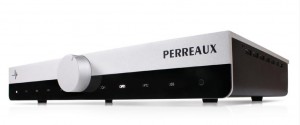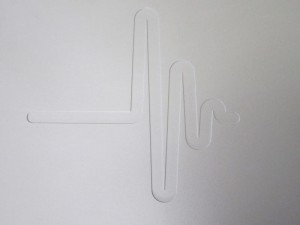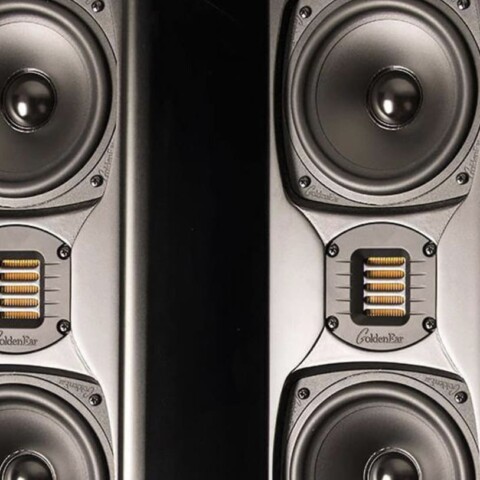Steel, Pearce and myself gathered at Pearce’s West Auckland pad to take our first look at Perreaux’s new Audiant integrated amplifier, arguably the most important piece of kit in the Perreaux stable. Why important? It’s the product (and the first part of a range) that will make or break the Perreaux brand in the stores of its new distribution partner – Harvey Norman.

Where the Silhouette range is a little too left field for the average punter, the Eloquence range is over the top for all bar the most hardcore of Harvey Norman shoppers. On the other hand, a sleek, modern looking integrated with digital connectivity options at the three grand mark is going to float many a boat, especially in the never-never wonderland of interest free deals. Assuming of course that the amp sounds good.
Before we get to the amp and its sonics, I know that there’s a theory out there that because punters buy expensive TVs at Harvey Norman, they should have no hassle buying amplifiers at an equivalent price point. Good luck with that. If you believe this theory, then I’ve got a bridge to sell you (bring cash). Many see a huge TV as a major improvement to their lifestyle, as a status symbol and as something they can share with the family. They don’t feel the same about an amplifier, particularly one that only plays in stereo. So three grand of amp is in a sweet spot that will sit well with many.

The Audiant isn’t just an amp, it’s a new generation digital hub of sorts. It’s got as many digital inputs as analogue inputs (two line inputs, one home theatre input and one MM phono input plus two optical, one RCA coax and one USB). This tells you a lot about where Perreaux sees the market going. The Audiant could well be set up without any form of disk player, just plug in a USB cable and use the built in 24/96 upsampling DAC – hey presto, hi-fi system!
The Audiant looks better in the flesh than it does in the pictures; the shiny black touch panel under the silver facia is up to date and should look just right in a modern AV rack. It certainly won’t be out of place in a department store and it won’t alienate the female part of the buying equation by being too big, too ugly or too imposing. With just the one volume knob and no digital display, it really does tend towards a minimalist look but the touch panel adds some visual and tactile bling that stops it being too hair shirt stark.

This is an 80 watt amp (into 8 Ohms, it runs a claimed 130 into 4 Ohms) and it’s far heavier than it looks. Despite being small enough to rock up in a medium sized aluminium suitcase (thanks to Cain from Perreaux for dropping it off), it weighs 11.5 kg and feels solid as a rock; there’s no hot air in there. The weight comes courtesy of a huge toroidal transformer, which is squat thanks to the low height of the unit but it seems to run front to back. The front and top panel is a single thick slab of aluminium, which acts as the heatsink with all the output devices placed against it.
The unit we listened to is a preproduction model, which has clattered its way up through both islands on a ticky tour. It was apparently run flat out until the thermal protection circuit shut it down by a certain nameless store, so it’s had a hard life. The analogue inputs weren’t responding to the touchscreen, so we ran it from Pearce’s Squeezebox Duet and his Jungson Moon Harbour CD player into the Audiant’s DAC using the coax input. Speaker cables were Nordost and speakers were Castle Harlechs

I picked up the Perreaux house sound very quickly, the MOSFETs have a certain sound to them and my 25 watt Sillhouette SX25i has it, as does the Eloquence 250i, the Radiance 200i and even Steel’s old Perreaux pre/power combo. Slightly well lit at the top, very detailed but by no means harsh. With the Castles, I was aware of a lot of energy at the top end but never felt a need to reach for a volume control, even when Pearce and Steel were playing their tuning signals (i.e. electronica), neither of them were seen to be flinching, so it seems they weren’t finding it too toppy either.

The bottom end seemed very much under control (a point we all remarked on) with bass that was tight and deeper than seems reasonable from the small drivers of the Castles. The midrange was squeaky clean and open. There was even good imaging to boot. Even at some reasonably loud volume levels, the Audiant was composed and enjoyable to listen to. In fact, the more I listened, the more I liked it.
We’ll do a full review when we can get a production model (soon I hope) but based on a few hours with this early unit, I’d say Perreaux has probably got it right. Right price, right looks, right power output, right blend of features, right sound quality.

Yeah the audio nerds will moan about the looks, complain about the lack of 24/192 upsampling and generally go on about everything from the lack of an MC phono stage to the missing old school source selection knobs. Let them. A lot of Kiwis will like what they see and what they hear, so I reckon this amp is going to sell very well in both chain and specialist environments. Bang a set of my favourite small speakers (Theophany M3b) on the end on an Audiant, run a good CD player or even USB from a PC as a source and you’re looking at a hot NZ combination.
Gary Pearce’s video preview of the Audiant can be found here
















I’ve mentioned elsewhere on the web, the Audiant looks set to be the benchmark radiogram for the 21st century. It’s not meant as a perjorative description, although some read it like that.
It’s hard not to see the Audiant from this perspective considering who will sell it, and who goes to shop there.
You have provided us with a palate-cleansing view of the product, which is appreciated. I’m looking forward to the review of the final version.